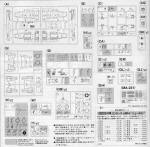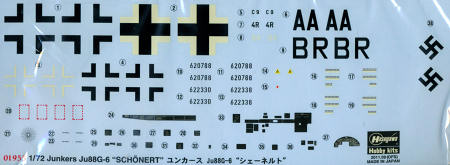
Hasegawa 1/72 Ju-88G-6 "Schönert"
| KIT #: | 01955 |
| PRICE: | $46.35 at www.greatmodels.com ($58.00 SRP) |
| DECALS: | Two options |
| REVIEWER: | Scott Van Aken |
| NOTES: | Limited reissue with photo etch fret |

| HISTORY |
Rudolf Schönert was the fifth highest scoring night fighter ace of WWII. His military career was not the norm as he started his adult career on the seas. After five years in the Merchant Navy, Schönert began flight training in 1933 and went on to fly commercial aircraft for Lufthansa. He was commissioned as a Leutnant in the Luftwaffe's Reserve in 1938 and in June 1941 joined 4./NJG1 at Bergen in northern Holland. He gained his first victories on 9 July 1941 and by 25 July 1942 his total stood at 22 and he was awarded the Knight's Cross.
Schönert is universally recognised as the driving force behind the introduction of upward-firing armament in night fighter aircraft the first prototype of which he introduced into his own Do-17 in 1942. The concept, dubbed Schräge Musik was initially rejected by Helmut Lent and Werner Streib. Oberfeldwebel Paul Mahle, an armourer attached to II./NJG 5 at Parchim, worked closely with Rudolf Schönert and built his own working prototype of 'Schrage Musik', which was soon fitted to all of the Gruppe's aircraft.
Schönert claimed the first aerial victory with upward-firing guns in May 1943. By August Schönert was flying with NJG 100 over the Eastern Front, claiming some 30 Soviet night raiders by early 1944.
During a sortie east of the Elbe on 27 April 1945, an electrical fault rendered his radar unserviceable and his Ju-88G was shot down by an RAF Mosquito. Schonert survived and was rescued by German troops.
Surviving the war, Schönert was credited with 65 aerial victories claimed in 376 combat missions, including 35 Soviet flown aircraft, and was a holder of the Oak Leaves to the Knight's Cross. Schönert's radio and wireless operator was Oberfeldwebel Johannes Richter. Schönert passed away in late 1985.
| THE KIT |
 Despite
stiff competition from Italeri/Zvezda for the 1/72 Ju-88 market, Hasegawa seems
to have things well in hand. Typical of their business plan, each new boxing is
based on a common set of sprues to which are added items that are needed to
product the variant being kitted. This means quite a few small parts and an
equal number of inserts. To some modelers, this makes the kits overly fiddly
while to others this approach is lauded as being the way to get the most
accurate kit available.
Despite
stiff competition from Italeri/Zvezda for the 1/72 Ju-88 market, Hasegawa seems
to have things well in hand. Typical of their business plan, each new boxing is
based on a common set of sprues to which are added items that are needed to
product the variant being kitted. This means quite a few small parts and an
equal number of inserts. To some modelers, this makes the kits overly fiddly
while to others this approach is lauded as being the way to get the most
accurate kit available.
Like most other makers of the Ju-88, the nose section and the fin/rudder are separate from the rest of the fuselage. In addition, Hasegawa relies on decals for most of the instrument panels and side consoles in the aircraft, though there is good detail there as well. Wing spars are used to help provide the sturdiness needed when attaching the wings. There is good wheel well and landing gear detail incorporated into the kit and while there are also aftermarket resin bits that will add just that much more detail, most modelers will be pleased with what is provided in the box.
Since this is a night fighter version, one will have to drill a bunch of holes in various parts of the airframe to accommodate the plethora of antennas; especially on Schönert's plane, which seems to have had more than the usual. Hasegawa's instructions provide exact measurements for the hole size and location needed. The kit includes a small etched fret and I have to say that I was disappointed that the main radar dipoles were not included on this fret. The plastic ones are just too fat to be totally realistic. Those wanting their antenna to look more prototypical would be best advised to locate aftermarket sets or to drill out the kit ones and replace the dipoles with fine wire.
 Markings are
provided for two aircraft. One is Schönert's plane as shown on the box art when
he was the Kommodore of NJG 5 in April of 1945. The other option is Walter
Beiegelb's 7./NJG 2 plane from March of 1945. This one has a mass of meandering
RLM 82 and RLM 83 squiggles over the standard RLM 76. Those of us who like to
paint short squiggles will probably choose this scheme as it is devoid of the
fuselage mounted antennas. Unlike Schönert's plane, this one has the tail
warning radar antenna. One needs to pay close attention to the rather densly
illustrated instructions as there are differences and modifications needed
depending on the option that is chosen.
Markings are
provided for two aircraft. One is Schönert's plane as shown on the box art when
he was the Kommodore of NJG 5 in April of 1945. The other option is Walter
Beiegelb's 7./NJG 2 plane from March of 1945. This one has a mass of meandering
RLM 82 and RLM 83 squiggles over the standard RLM 76. Those of us who like to
paint short squiggles will probably choose this scheme as it is devoid of the
fuselage mounted antennas. Unlike Schönert's plane, this one has the tail
warning radar antenna. One needs to pay close attention to the rather densly
illustrated instructions as there are differences and modifications needed
depending on the option that is chosen.
| CONCLUSIONS |
Ju-88 fans and those who like Luftwaffe night fighters will be pleased with this kit. It has a lot of detail and should make into a superlative model with some careful building.
| REFERENCES |
http://en.wikipedia.org/wiki/Rudolf_Schoenert
December 2011 I got this at
GreatModels,
where you can find tons of kits, books and accessories. If you would like your product reviewed fairly and fairly quickly, please contact the editor or see other details in the
Note to
Contributors.